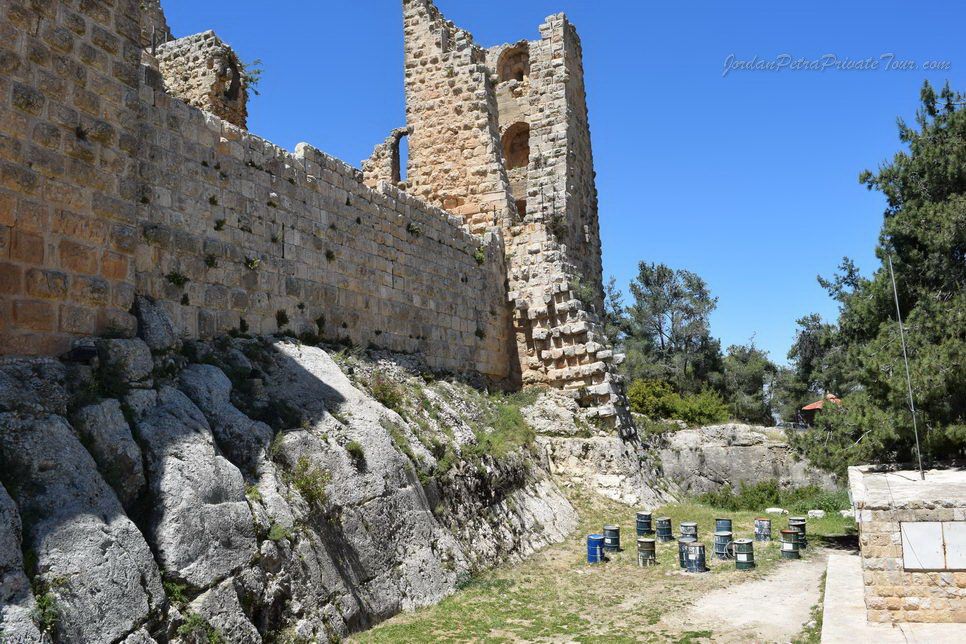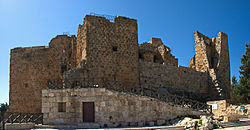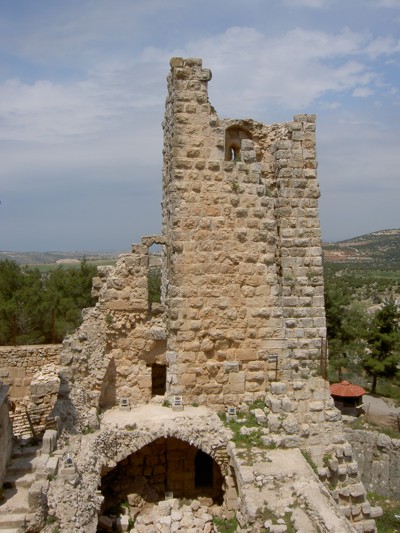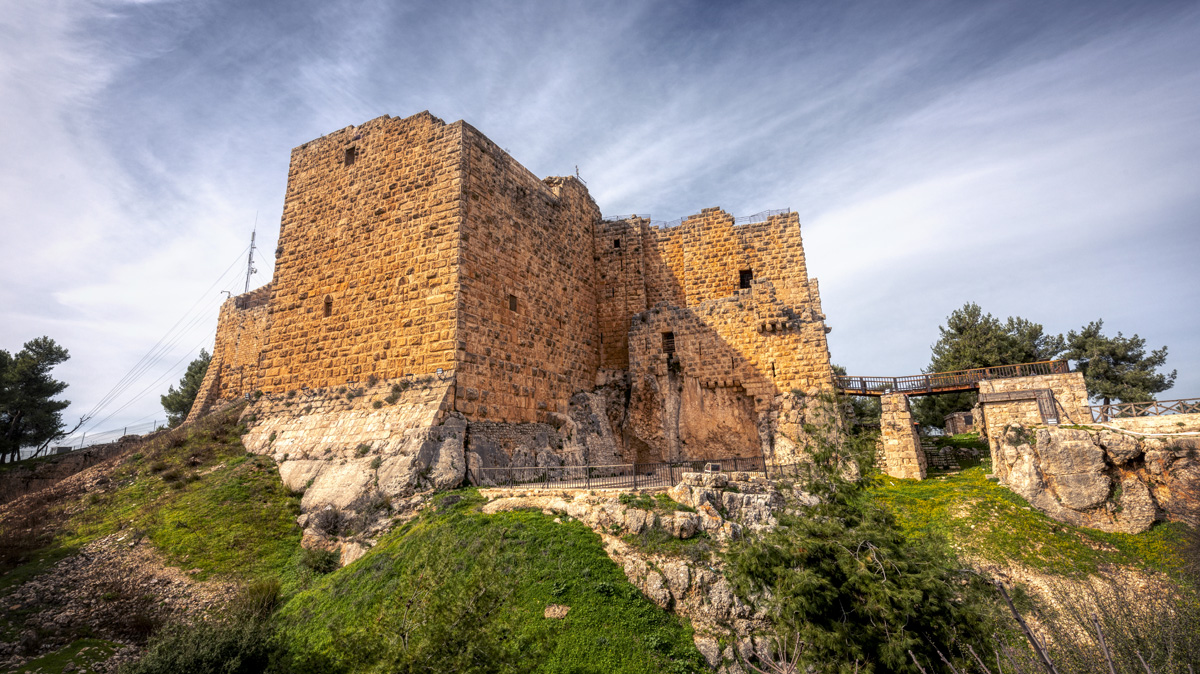The Untold Story of Ajloun Castle: From Crusader Fortress to Ottoman Outpost
Nestled in the picturesque town of Ajloun, Jordan stands the remarkable Ajloun Castle. This medieval fortress holds a rich and untold history that stretches from its origins as a strategic stronghold against crusader attacks to its transformation into an Ottoman outpost.
Join us as we delve into the captivating story of Ajloun Castle, uncovering its significant role in shaping the region's tumultuous past.

A brief overview of Ajloun Castle
Ajloun Castle, also known as Qala'at al-Rabad, is a historic fortress located in the Ajloun Governorate of Jordan. Situated atop a hill overlooking the city of Ajloun, the castle dates back to the 12th century and has played a significant role in the region's history. It was constructed during the time of the Ayyubid dynasty by the renowned military strategist and sultan, Salah ad-Din (Saladin).
The castle was strategically positioned to overlook the surrounding valleys and to serve as a defense against Crusader attacks. Its sturdy design, thick limestone walls, and multiple towers made it an impregnable fortress. The castle's location made it an effective lookout point, allowing the defenders to spot approaching enemies from a distance.
The castle lost its military significance during the Ottoman period and was transformed into an administrative outpost. It served as a khan (caravanserai) and a garrison for soldiers. Over time, earthquakes caused significant damage to the fortress, leading to its gradual decline.
In recent years, the Department of Antiquities of Jordan has undertaken efforts to restore and preserve Ajloun Castle. The castle has been reopened to tourists, offering visitors a glimpse into its rich history and architectural grandeur.
Ajloun Castle also houses a museum that showcases artefacts and exhibits related to its history. Visitors can explore the various rooms of the fortress, including the watchtower, the barracks, and the grand hall, providing a fascinating insight into the castle's past and the lives of its inhabitants.

Significance and historical importance of the castle
Ajloun Castle is of significant historical importance due to its strategic location and role in defending against Crusader attacks during the 12th and 13th centuries. Commissioned by the renowned Muslim military leader Saladin, the castle was designed to act as a formidable fortress protecting the surrounding region. Its sturdy design, featuring multiple defence mechanisms such as moats, drawbridges, and arrow slits, made it a difficult target for Crusader invaders.
The castle played a pivotal role in the region's defence, serving as a military stronghold for the Muslim forces against the Crusaders' repeated attempts to conquer the area. It became an essential symbol of resistance and a testament to the ability of the Muslim forces to withstand their enemies.
The castle lost its strategic importance during the Ottoman occupation but continued to serve as a residential and administrative centre. The Ottomans modified the structure, including adding a mosque and various residential quarters.
Unfortunately, the castle suffered severe damage from earthquakes over the centuries, which led to its decline and gradual abandonment. However, the Department of Antiquities of Jordan initiated extensive restoration efforts, allowing the castle to be reopened to tourists. Visitors now have the opportunity to explore the castle's grounds, including its towers, halls, and underground passages, while also experiencing a museum exhibition that showcases artefacts and provides a glimpse into the castle's rich history

Construction and Purpose of Ajloun Castle
Commissioning of the castle by Saladin
Ajloun Castle, located in the Ajloun Governorate of Jordan, has a rich and fascinating history dating back to the 12th century. The renowned Muslim military leader Saladin commissioned the castle in 1184 AD to defend against the Crusader attacks in the region. Saladin recognized the location's strategic importance, as it offered commanding views of the surrounding area.
Saladin's vision for Ajloun Castle was to create a fortress to deter and repel the Crusaders, who sought to regain control of the Holy Land. The castle's design and architecture were carefully planned to optimize its defensive capabilities. It featured thick stone walls, multiple towers, and a network of underground tunnels and cisterns to ensure a reliable water supply during times of siege.
Under Saladin's leadership, the castle played a crucial role in defending against Crusader attacks and was a key regional stronghold. Its strategic location allowed it to control important trade routes and maintain a watchful eye over the surrounding territory.
Today, the Department of Antiquities of Jordan has undertaken extensive restoration efforts to preserve the castle's historical significance and showcase its architectural beauty. Ajloun Castle has been reopened to tourists, allowing visitors to explore its impressive structures and learn about its captivating past. The castle also houses a museum exhibition that displays artefacts and exhibits related to its history, providing a glimpse into the untold story of this remarkable fortress.
Design and architecture of the fortress
Ajloun Castle, also known as Qala'at Ar-Rabad, is an impressive fortress in Ajloun, Jordan. The design and architecture of the fortress showcase the military ingenuity of its builders and the strategic importance of its location. The castle was constructed on a hilltop, providing a commanding view of the surrounding landscape and serving as a deterrent to potential invaders.
The fortress consists of multiple concentric walls and towers that were designed to withstand sieges. The outer walls were built with large limestone blocks, while the inner walls were constructed with smaller stones and gravel. This design made the fortress more resistant to artillery attacks and provided an additional layer of protection for the defenders.
Inside the castle, numerous rooms and chambers served various functions, including living quarters, storage areas, and mosques. The architecture of these spaces reflects the medieval Islamic style prevalent during that time. The castle also features a large cistern for water storage, which was crucial during times of siege.
The strategic design of Ajloun Castle allowed its garrison to defend against Crusader attacks during the 12th century effectively. The fortress played a vital role in safeguarding the region and maintaining the balance of power in the area.
Today, visitors can explore the castle and witness its impressive architecture firsthand. The Department of Antiquities of Jordan has undertaken significant restoration efforts to preserve and showcase the historical significance of Ajloun Castle. The castle is now open to tourists, offering a glimpse into its storied past. Inside, a museum exhibition highlights artefacts related to the castle's history, giving visitors a deeper understanding of its significance in the region.

Role of the castle in defending against Crusader attacks
Ajloun Castle played a crucial role in defending against Crusader attacks during the Middle Ages. As a strategically located fortress, the castle provided a strong defense against the Crusader forces that aimed to expand their influence in the region. The fortress, commissioned by Saladin in the 12th century, was strategically built on a hilltop with commanding views of the surrounding area.
The castle's design and architecture were tailored to withstand sieges and attacks. Its thick limestone walls, multiple layers of defence, and strategic positioning made it difficult for the Crusaders to breach its defenses. The castle also featured a moat, drawbridge, and engaging outer towers to deter potential invaders further.
During the Crusader period, the castle served as an important military stronghold in the region. It played a vital role in repelling numerous Crusader attacks and protecting the nearby territories from invasion. The fortress's strategic location allowed the Muslim forces to monitor enemy movements and launch counterattacks when necessary effectively.
The role of Ajloun Castle in defending against Crusader attacks showcases its historical significance and the importance it held during the tumultuous times of the Crusades. Today, the castle stands as a testament to the region's rich history and attracts tourists from all over the world who are eager to explore its fascinating past.

Transition to Ottoman Rule
Utilization of the castle as a military stronghold by the Ottoman Turks
In the 16th century, the Ajloun Castle, originally built as a fortress to defend against Crusader attacks, was repurposed by the Ottoman Turks as a military stronghold. The castle's strategic location atop a hill gave them a vantage point for surveillance and defence.
The castle underwent significant renovations and expansions during the Ottoman occupation, transforming it into a formidable fortress. The Ottomans reinforced the castle's fortifications, adding thick defensive walls and towers to enhance its defensive capabilities. They also constructed cisterns and storage facilities within the castle to ensure a steady supply of water and provisions during times of siege.
The castle was crucial in protecting the Ottoman-controlled regions from external threats and served as a base for their military operations. Its strategic position allowed the Ottoman forces to monitor and control the surrounding areas as a strong deterrent against potential attacks. The Ottomans used the castle to maintain their presence and control in the region for many years.
Today, visitors can explore the remnants of the Ottoman modifications, including the reinforced walls, towers, and the well-preserved cisterns. These structures stand as a testament to the castle's role as a military stronghold during the Ottoman era and offer a glimpse into the history and military tactics of the time.

Impact of the Ottoman occupation on the castle
The Ottoman occupation had a significant impact on Ajloun Castle. During this period, the castle underwent several modifications and adaptations to suit the needs of the Ottoman military better:
-
Expansion and Reinforcement: The Ottomans recognized the strategic importance of Ajloun Castle and invested in expanding and reinforcing its fortifications. They constructed additional walls, towers, and bastions to enhance their defensive capabilities against potential threats.
-
Military Usage: The Ottomans utilized Ajloun Castle as a military outpost, a base for their forces and a centre for controlling the surrounding region. Its strategic location gave them an advantage in monitoring and controlling potential threats from rival powers, including the expanding European colonial powers.
-
Administrative Center: Alongside its military function, Ajloun Castle also served as an administrative centre for the region under Ottoman rule. Local officials managed the collection of taxes, the resolution of disputes, and the enforcement of Ottoman laws from within the castle's premises.
-
Infrastructure Improvements: The Ottoman occupation led to various infrastructure improvements around the castle, including constructing water cisterns and other facilities for the convenience of the garrison and inhabitants.
Despite the alterations made during the Ottoman period, Ajloun Castle retains its historical and architectural significance, offering visitors a glimpse into its rich past and the various civilizations that have shaped its legacy. Today, the Department of Antiquities of Jordan works diligently to preserve and restore the castle, ensuring that future generations can continue to appreciate its historical and cultural value.

Earthquakes and their effect on the fortress
The Ajloun Castle has witnessed numerous earthquakes throughout its history, and these seismic events have had a significant impact on the fortress:
-
Earthquake Damage: Over the centuries, earthquakes have caused varying degrees of damage to the castle. The most severe of these occurred in the 19th century, resulting in the collapse of several sections of the fortress and leaving it in ruins.
-
Architectural Instability: The repeated earthquakes have weakened the castle's walls and towers' structural integrity, posing restoration challenges. The ongoing seismic activity in the region necessitates constant maintenance and monitoring to ensure the safety of visitors.
-
Preservation Challenges: The earthquakes have also affected the preservation of historical artefacts within the castle. These valuable items have been exposed to the vibrations and potential dangers caused by seismic activity, requiring careful handling and conservation measures.
-
Restoration Efforts: The Department of Antiquities of Jordan has undertaken extensive restoration work to repair earthquake damage and stabilize the castle's structures. Skilled craftsmen and experts in historic preservation have worked meticulously to ensure accuracy and authenticity in the restoration process.
-
Tourist Experience: Despite the challenges posed by earthquakes, the castle has been reopened to tourists, allowing visitors to explore its rich history and architectural marvels. The restoration efforts have made it possible for tourists to experience the grandeur of the fortress and learn about its historical significance.
The earthquakes that have affected the Ajloun Castle serve as a reminder of the castle's resilience and the ongoing efforts to preserve and showcase its remarkable history.

Restoration and Preservation
Efforts by the Department of Antiquities of Jordan to restore the castle
Efforts by the Department of Antiquities of Jordan to restore Ajloun Castle have been underway for several years. The department recognized the historical significance of the castle and its potential as a tourist attraction. Restoration work began in the late 20th century and aimed to preserve the fortress's unique architectural features and historical integrity.
The restoration process involved a meticulous approach, with experts carefully examining the original design and layout of the castle. Skilled craftsmen used traditional techniques and materials, ensuring the restoration remained faithful to the original construction. This attention to detail has helped maintain the castle's authenticity and provide visitors with an immersive experience of its historical significance.
Today, the restored Ajloun Castle stands as a testament to the dedication and expertise of the Department of Antiquities of Jordan. It serves as a remarkable example of the preservation of historical heritage and provides visitors with a glimpse into the region's rich history.
Highlights of the restoration efforts:
- Structural stabilization to reinforce the castle's foundations and walls.
- Repairs to damaged areas, including roofs and floors, to ensure the safety of visitors.
- Reconstruction of collapsed sections based on historical documentation and archaeological findings.
- Restoration of interior spaces, including the chambers, galleries, and halls, to showcase their original design and architectural elements.
- Installation of informative signage and displays to educate visitors about the history and significance of the castle.
These efforts have successfully transformed Ajloun Castle into a must-visit destination for travellers interested in experiencing Jordan's fascinating historical past.

Reopening of the castle to tourists
After extensive restoration and preservation efforts by the Department of Antiquities of Jordan, Ajloun Castle has been reopened to tourists, allowing them to explore the rich history and architectural beauty of this ancient fortress. The reopening of the castle provides visitors with a unique opportunity to step back in time and experience the grandeur of a medieval stronghold.
Visitors to Ajloun Castle can now enjoy guided tours that take them through the various sections of the fortress, including the towers, halls, and courtyards. The tours provide insight into the history of the castle and its significance in the region, offering a deeper understanding of its role in defending against Crusader attacks during the medieval period.
In addition to guided tours, the castle also features a museum exhibition that showcases artefacts and archaeological discoveries related to its history. Visitors can marvel at ancient weapons, pottery, and other artefacts unearthed in and around the castle, providing a glimpse into the daily life of the people who once inhabited the fortress.
The reopening of Ajloun Castle to tourists contributes to the preservation of this cultural heritage site and boosts tourism in the region, providing an economic benefit to local communities. Visitors can now immerse themselves in the rich history and captivating stories of Ajloun Castle, making it a must-visit destination for history enthusiasts and travellers alike.
Museum exhibition and artefacts related to the castle's history
The museum exhibition at Ajloun Castle offers a fascinating glimpse into the history and artefacts related to this historic fortress. Visitors can explore displays showcasing the castle's rich history and the people who inhabited it over the centuries.
One of the museum's highlights is the collection of archaeological finds from the castle and its surrounding area. Visitors can see ancient pottery, weapons, and architectural fragments that provide insight into the daily lives of the castle's occupants.
The exhibition also features interactive displays that allow visitors to learn more about the castle's role in defending against Crusader attacks and the tactics used during battles. Models and dioramas bring to life the castle's strategic position and importance in the region.
Visitors can also explore the castle's architectural design and learn the techniques used to construct the fortress. Artefacts such as architectural drawings and construction tools shed light on the craftsmanship and ingenuity of the castle's builders.
The museum also showcases the impact of the Ottoman occupation on the castle and the changes made to adapt the fortress to the needs of the Ottoman military. Visitors can see Ottoman-era artefacts and learn about the daily life of soldiers stationed at the castle.
Overall, the museum exhibition at Ajloun Castle is a must-visit for history enthusiasts and provides a captivating journey through the castle's past.
